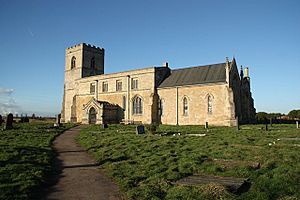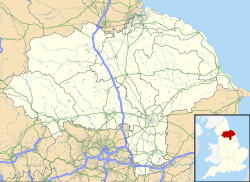Church of St Edmund King and Martyr, Kellington facts for kids
Quick facts for kids St Edmunds' Church |
|
|---|---|
| Church of St Edmund King and Martyr, Kellington | |

St Edmund's church
|
|
| 53°42′53″N 1°10′16″W / 53.7146°N 1.1712°W | |
| OS grid reference | SE547245 |
| Location | Kellington, North Yorkshire |
| Country | England |
| Denomination | Church of England |
| History | |
| Status | Active |
| Architecture | |
| Architectural type | Norman Early English Decorated |
| Specifications | |
| Height | 54 feet (16 m) (tower) |
| Administration | |
| Parish | Kellington |
| Benefice | Knottingley and Kellington with Whitley |
| Deanery | Pontefract |
| Archdeaconry | Pontefract |
| Diocese | Leeds |
The Church of St Edmund King and Martyr, Kellington, is a very old church. It was built in the 12th century, which means it's over 800 years old! This special church is in the village of Kellington, in North Yorkshire, England. It's so important that it's a "grade I listed" building. This means it's one of the most important historic buildings in the country.
Long ago, people found a 14th-century tomb here that might be linked to the Knights Templar. In the 1990s, the church's foundations were made stronger. This was done because a nearby coal mine, Kellingley Colliery, might have made the ground sink.
The church stands on a small hill, a bit away from the village. This makes it easy to spot and a well-known local landmark. People have talked about its beauty for hundreds of years. Inside the church, there's a special stone with old carvings. This stone has a cool legend about a shepherd who fought a snake! This "Kellington Serpent-Stone" is one of the church's most interesting features.
Contents
History of St Edmund's Church
The church is located about 400 meters (a quarter of a mile) west of the village. It sits on a small hill. Some people think this hill might have been a special religious place even before the current church was built. They believe a Saxon church might have stood there first.
An old writer named Roger Dodsworth said the church was in "splendid isolation" from the village. This means it stood beautifully by itself. The local council also says the church "dominates the skyline" and is a "particularly fine Grade I listed building."
Knights Templar and Early Ownership
The church was first written about in the late 12th century. At that time, the Knights Templar were in charge of it. The Knights Templar were a powerful group of Christian knights. They owned a lot of land in the area around Kellington.
The church was likely built before 1177. This is because a man named Henri de Lacy gave it to the Knights Templar before he died in 1177 during a Crusade. A vicar, who is a church leader, was first mentioned in 1291. In 1307, a survey said the Templars used the church for themselves.
However, in 1308, a sheriff named Sir John Crepping took over the Templars' lands. This included the church at Kellington. Many Knights Templar were buried at Kellington. Sadly, some of their graves have been lost over time due to church repairs.
In 1310, the church was given to Sir Miles de Stapleton. But he only kept it for three years. By 1342, St Edmund's Church was owned by another group of knights, the Knights Hospitaller. After them, the church's ownership and the right to choose its vicar went to Trinity College in Cambridge.
Church Building and Design
Since the church started in the Norman period, the main part of it is in the Norman style. This style often features thick walls and round arches. The church tower was added later. Over the years, the church has been repaired and updated many times. These changes have added other building styles, like Early English and Decorated architecture.
The Kellington Serpent-Stone Legend
In 1548, a special stone called the Kellington Serpent-Stone was moved. It had been in a hidden spot in the church. This stone is made of magnesian limestone. It has a fancy carved sword down the middle. On one side is a human figure, and on the other is a "grotesque" figure.
The stone was moved outside to the churchyard. But the weather started to damage it. So, in the 1920s, it was brought back inside the church. The best description of the stone before it got worn down was by Roger Dodsworth in 1621. He said the strange figure was a "flying serpent." He also mentioned a local story about a shepherd who killed the serpent but died in the fight.
Modern Times and Repairs
In the late 1850s, the vicar of Kellington, Joseph Mann, helped raise money for a smaller church in nearby Whitley. This became All Saints' Parish Church. It was like a "daughter church" to St Edmund's. Both churches even held services together with local Methodist groups in the 1960s and again in the 2000s.
In the 1990s, there was a risk that the ground might sink because of the nearby Kellingley Colliery coal mine. To stop the church from collapsing, its foundations needed to be made stronger. This process is called "underpinning."
Before the underpinning, archaeologists carefully dug up burials inside the church. This happened from October 1990 to April 1991. The team was led by Richard Morris, Julie Dunk, and Ian Lawton. As part of the church's repair, many of the dug-up skeletons were placed in a special room called an ossuary, built under the tower.
British Coal spent a lot of money, about £1 million in 1991, to make sure the church would be safe. The church tower was taken apart and then rebuilt exactly as it was before. More repairs and updates were done in the 21st century. During earlier repairs, workers found that the church's original floor was made of rough limestone pieces held together with mortar.
Other Historic Structures at the Church
Besides the church itself, which is a very important "Grade I listed" building, there are two other structures in the churchyard that are also listed with Historic England. This means they are protected because of their historical importance.
- The gate pillars at the entrance to the churchyard, which were built in 1698.
- The churchyard cross, an old stone cross.
Also, the churchyard is registered with the Commonwealth War Graves Commission. This means it contains graves or memorials for soldiers who died in wars.
See also
- Grade I listed buildings in North Yorkshire (district)
- Listed buildings in Kellington


